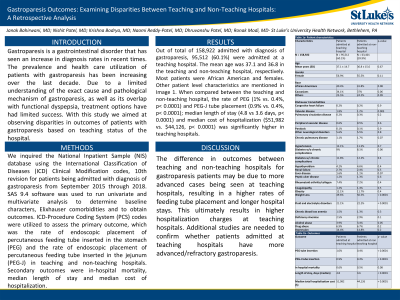Monday Poster Session
Category: Functional Bowel Disease
P1945 - Gastroparesis Outcomes: Examining Disparities Between Teaching and Non-Teaching Hospitals: A Retrospective Analysis
Monday, October 23, 2023
10:30 AM - 4:15 PM PT
Location: Exhibit Hall

Has Audio

Janak Bahirwani, MD
St. Luke’s University Health Network
Bethlehem, PA
Presenting Author(s)
Janak Bahirwani, MD1, Krishna Bodrya, MD2, Dhruvanshu Patel, MD3, Nishit Patel, MD3, Naomi Reddy-Patel, MD3, Ronak Modi, MD3
1St. Luke’s University Health Network, Bethlehem, PA; 2Western Reserve Health Education, Niles, OH; 3St. Luke's University Health Network, Bethlehem, PA
Introduction: Gastroparesis is a gastrointestinal disorder that has seen an increase in diagnosis rates in recent times. The prevalence and health care utilization of patients with gastroparesis has been increasing over the last decade. Due to a limited understanding of the exact cause and pathological mechanism of gastroparesis, as well as its overlap with functional dyspepsia, treatment options have had limited success. With this study we aimed at observing disparities in outcomes of patients with gastroparesis based on teaching status of the hospital.
Methods: We inquired the National Inpatient Sample (NIS) database using the International Classification of Diseases (ICD) Clinical Modification codes, 10th revision for patients being admitted with diagnosis of gastroparesis from September 2015 through 2018. SAS 9.4 software was used to run univariate and multivariate analysis to determine baseline characters, Elixhauser comorbidities and to obtain outcomes. ICD-Procedure Coding System (PCS) codes were utilized to assess the primary outcome, which was the rate of endoscopic placement of percutaneous feeding tube inserted in the stomach (PEG) and the rate of endoscopic placement of percutaneous feeding tube inserted in the jejunum (PEG-J) in teaching and non-teaching hospitals. Secondary outcomes were in-hospital mortality, median length of stay and median cost of hospitalization.
Results: Out of total of 158,922 admitted with diagnosis of gastroparesis, 95,512 (60.1%) were admitted at a teaching hospital. The mean age was 37.1 and 36.8 in the teaching and non-teaching hospital respectively. Most patients were African American and females. Other patient level characteristics are mentioned in Image 1. When compared between the teaching and non-teaching hospital, the rate of PEG (1% vs. 0.4%, p< 0.0001) and PEG-J tube placement (0.9% vs. 0.4%, p< 0.0001); median length of stay (4.8 vs 3.6 days, p< 0.0001) and median cost of hospitalization ($51,982 vs. $44,126, p< 0.0001) was significantly higher in teaching hospitals.
Discussion: The difference in outcomes between teaching and non-teaching hospitals for gastroparesis patients may be due to more advanced cases being seen at teaching hospitals, resulting in a higher rates of feeding tube placement and longer hospital stays. This ultimately results in higher hospitalization charges at teaching hospitals. Additional studies are needed to confirm whether patients admitted at teaching hospitals have more advanced/refractory gastroparesis.
Disclosures:
Janak Bahirwani, MD1, Krishna Bodrya, MD2, Dhruvanshu Patel, MD3, Nishit Patel, MD3, Naomi Reddy-Patel, MD3, Ronak Modi, MD3. P1945 - Gastroparesis Outcomes: Examining Disparities Between Teaching and Non-Teaching Hospitals: A Retrospective Analysis, ACG 2023 Annual Scientific Meeting Abstracts. Vancouver, BC, Canada: American College of Gastroenterology.
1St. Luke’s University Health Network, Bethlehem, PA; 2Western Reserve Health Education, Niles, OH; 3St. Luke's University Health Network, Bethlehem, PA
Introduction: Gastroparesis is a gastrointestinal disorder that has seen an increase in diagnosis rates in recent times. The prevalence and health care utilization of patients with gastroparesis has been increasing over the last decade. Due to a limited understanding of the exact cause and pathological mechanism of gastroparesis, as well as its overlap with functional dyspepsia, treatment options have had limited success. With this study we aimed at observing disparities in outcomes of patients with gastroparesis based on teaching status of the hospital.
Methods: We inquired the National Inpatient Sample (NIS) database using the International Classification of Diseases (ICD) Clinical Modification codes, 10th revision for patients being admitted with diagnosis of gastroparesis from September 2015 through 2018. SAS 9.4 software was used to run univariate and multivariate analysis to determine baseline characters, Elixhauser comorbidities and to obtain outcomes. ICD-Procedure Coding System (PCS) codes were utilized to assess the primary outcome, which was the rate of endoscopic placement of percutaneous feeding tube inserted in the stomach (PEG) and the rate of endoscopic placement of percutaneous feeding tube inserted in the jejunum (PEG-J) in teaching and non-teaching hospitals. Secondary outcomes were in-hospital mortality, median length of stay and median cost of hospitalization.
Results: Out of total of 158,922 admitted with diagnosis of gastroparesis, 95,512 (60.1%) were admitted at a teaching hospital. The mean age was 37.1 and 36.8 in the teaching and non-teaching hospital respectively. Most patients were African American and females. Other patient level characteristics are mentioned in Image 1. When compared between the teaching and non-teaching hospital, the rate of PEG (1% vs. 0.4%, p< 0.0001) and PEG-J tube placement (0.9% vs. 0.4%, p< 0.0001); median length of stay (4.8 vs 3.6 days, p< 0.0001) and median cost of hospitalization ($51,982 vs. $44,126, p< 0.0001) was significantly higher in teaching hospitals.
Discussion: The difference in outcomes between teaching and non-teaching hospitals for gastroparesis patients may be due to more advanced cases being seen at teaching hospitals, resulting in a higher rates of feeding tube placement and longer hospital stays. This ultimately results in higher hospitalization charges at teaching hospitals. Additional studies are needed to confirm whether patients admitted at teaching hospitals have more advanced/refractory gastroparesis.
Disclosures:
Janak Bahirwani indicated no relevant financial relationships.
Krishna Bodrya indicated no relevant financial relationships.
Dhruvanshu Patel indicated no relevant financial relationships.
Nishit Patel indicated no relevant financial relationships.
Naomi Reddy-Patel indicated no relevant financial relationships.
Ronak Modi indicated no relevant financial relationships.
Janak Bahirwani, MD1, Krishna Bodrya, MD2, Dhruvanshu Patel, MD3, Nishit Patel, MD3, Naomi Reddy-Patel, MD3, Ronak Modi, MD3. P1945 - Gastroparesis Outcomes: Examining Disparities Between Teaching and Non-Teaching Hospitals: A Retrospective Analysis, ACG 2023 Annual Scientific Meeting Abstracts. Vancouver, BC, Canada: American College of Gastroenterology.
